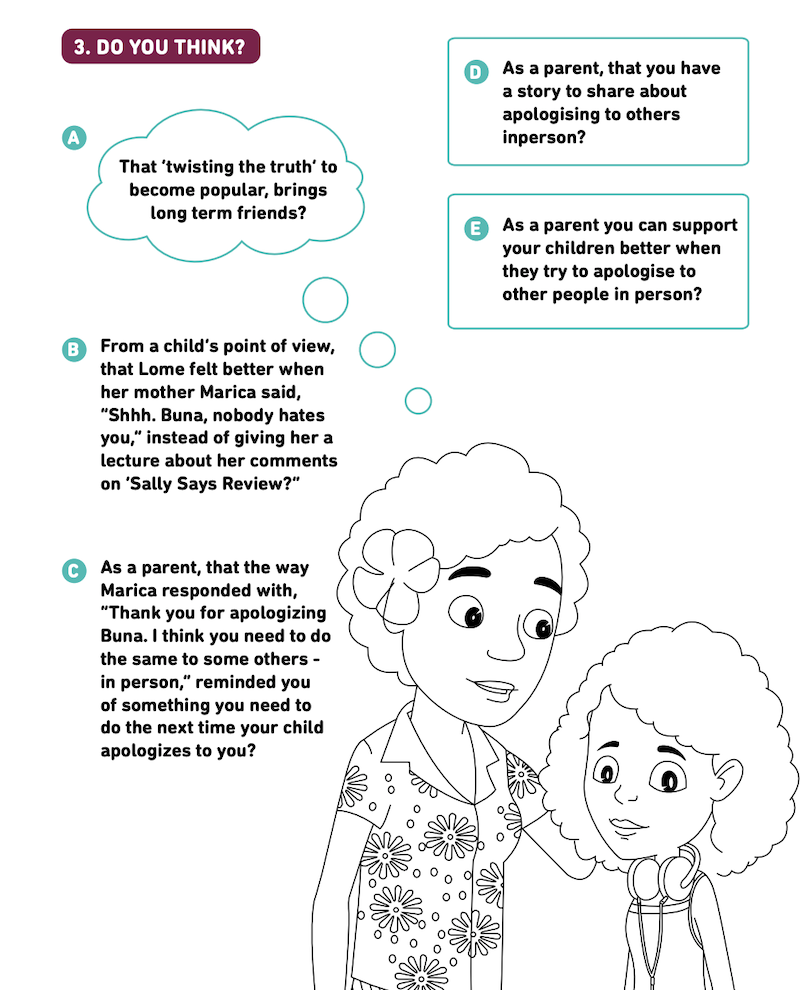“I dunno” is an answer you’re probably familiar with as a parent. Sometimes you can’t get kids to be quiet and other times it’s impossible to get a word from them.
First of all, I should establish that the value of conversation isn’t measured by how well-spoken our children are, their ability to charm or their social graces.
I see conversation as having the ability to pass on stories of faith, share our relationship with God, create space for questions, and give us opportunities to listen and encourage our children as they navigate the challenges of developing their own relationship with God.
And on the surface, this seems like a simple problem with a simple solution—just have more conversations. However, never has this been more challenging than in the digital age. So on top of the screen time debate that was previously underway, we’ve now added education and family interactions.
Our children are being bombarded with the lure of technology everywhere they turn. Their brains function in a stimuli-saturated environment; then, we ask them to focus, engage, relate, emote and believe in an unseen God. And so we must ask and wrestle with the question: How can we create space for meaningful conversations with children in the digital age?
Why is conversation important?
From the moment we bring a child into the world, we begin a journey to know them and engage with them. From our efforts to tickle them and see them giggle with delight, to our slow speech designed to help them understand the sounds and rhythms of their mother tongue, our human inclination is toward conversation: Talking and listening, giving an answer and getting a response, hearing and reacting.
Even in Jesus’ interactions on earth, we see many examples of conversation. We see the disciples asking Jesus questions and getting responses from Him. We see Him engaging with people in meaningful conversation.
It’s through conversation that we explore and expose some of our core values and beliefs. It is through conversation that parents, mentors and leaders can listen, provide a safe space and when necessary, challenge our thinking.
In their paper “Talking about Religion: How Highly Religious Youth and Parents Discuss Their Faith”, David Dollahite and Jennifer Thatcher interviewed 57 highly religious married couples with children to understand the impact parent-adolescent conversation has on faith development. They also looked at different types of conversation patterns and how the parent-adolescent relationship fared from the interaction. We will explore some of their findings in this article.
One Seventh-day Adventist family, cited by David, had previously been studied in the paper “Family Worship Patterns and Their Correlation with Adolescent Behavior and Beliefs”. The initial study found that parents who have family worship in which children don’t participate, and who simply sit and listen had less active faith than those children whose parents had no worship at all.
Making space for our kids to have meaningful conversations is critical.
So, when we’re asking what we can do in a technology-driven world that an algorithm can’t and what we can provide when so much is at their fingertips, one simple answer is conversation.
Conversation not only transmits values from one side, it allows others to evaluate those values and confirm, ponder or reject them. Conversation provides a platform for relationship building. Conversation is the place for storytelling and self-disclosure. It is through conversation that we can assure a person in their vulnerabilities and provide the acceptance that someone is longing for.
So, in the midst of busy family life, live-streamed church services and online classrooms, how can we create space for meaningful conversation?
What does it mean to create space?

Creating space is about blocking out the time, choosing the location, creating the silence and developing the intentionality for conversations to happen. It’s less about limiting screen time for the sake of staying within the Paediatrician Association’s guidelines and more about the intentionality to leave space to spark conversation, spawn a new idea or draw out a question. It’s about creating the mystery of “what will happen next?” if we were to avoid filling every moment with something.
Creating space in time
As parents, we should note when kids are most likely to engage in conversation. In this way, we can make a routine so there is a safe place set aside for them to feel comfortable to talk to us.
We should note for ourselves that this may be about limiting not just our children’s screen time but also our own screen time. This may help our children know we’re open and available to talk when they’re ready.
Creating space with silence
Recently, I’ve been training as an organisational coach, and one of the tools we’re equipped with to help people reach their potential is silence. When it comes to conversation, creating silence is a great way to encourage conversation and leave space for others to speak.
In an article published in the Harvard Business Review titled, “If You Want People to Listen, Stop Talking”, businessman Peter Bergman advises, “Let other people speak into the silence and listen quietly for the truth behind their words. Then acknowledge what you’ve heard (which is, most likely, more than has been said) and, once the others feel seen and heard, offer your view.”
In David and Jennifer’s study, they noted that the most effective type of conversation between a parent and child is conversation that is initiated and ended by the adolescent (versus conversation that is initiated and ended by the parent) and is centred on the needs of the adolescent.
On the contrary, David and Jennifer found when the conversation was initiated by the parent, the adolescents were less engaged in the conversation. Also, the adolescents tended to check out before the parents were done talking, leaving the adolescent feeling the conversation had dragged on after they were interested. This had the effect of causing a negative impact on the parent-adolescent relationship.
Creating physical space
In David and Jennifer’s study, they noted that amongst the 57 families studied, there were a couple of common areas where religious conversations took place. One place was at home, often at the dinner table. The second place was in the car, sometimes on the way to religious events, worship services and other events.
Julie Weslake, former children’s ministry director for the Seventh-day Adventist Church in the South Pacific, suggests that parents can create a worship space in their home that designates to kids that special activities happen in that space.
Setting aside a physical space can spark questions around the need for the space and the meaning it has.
Do you as a parent have a special place where you connect and have conversations with your children? Does your church?
Creating space with intentionality
As parents, youth leaders and religious institutions look to engage children in a world that is increasingly digital, the question becomes how can we create space for meaningful conversations for children, even if the discussion is initiated online?
Intentionality means planning spaces for children to join in the worship service online or in person, asking for their input and placing intentional pauses in our day.
Technology can both decrease and stimulate conversation, depending on what we do with it.
However, because building relationships with God and one another are at the core of what we do, we have to find ways to make technology stimulate conversation.
One example of how this can work can be seen in The Tuis TV show created by the Seventh-day Adventist Church in the South Pacific children’s ministry department and Adventist Media.
Litiana Turner, creator of the show, describes the purpose of the The Tuis as providing a space to make parents the heroes of their children’s spiritual lives by providing a platform for children to engage with their parents as they watch the show.
At the end of each episode, there’s a workbook parents can download with questions they can ask and use to engage with their children.
The model presented with The Tuis TV show encourages parents to co-view programming with children and allow the content to be a springboard for conversation. This methodology can be useful with other forms of media as well.

What if we don’t have the right answer?
So, if technology has the ability to stimulate conversation, could it be that something else might stand in the way of meaningful interactions?
Could it be that we avoid conversation because of the fear of what it might uncover: Our own vulnerabilities, our questions, our fears, and the possibility that we don’t know the right answer.
This may be the biggest elephant in the room when it comes to religious conversations with kids: What if we don’t know the right answer? Or what if they ask a question we can’t answer? Then what do we do?
Pastor Daron Pratt, kids’ chaplain with the Seventh-day Adventist Church, says we as parents often wonder what to do if our child asks us a question we can’t answer. He advises parents to be authentic and real, directing and seeking. He encourages us as parents to take a position as a co-learner and explorer with our children.
Another resource commissioned and created by Hope Channel and the Seventh-day Adventist Church in the South Pacific children’s ministry department provides a way for parents to be co-learners with children as they leverage available technology. The show, entitled, The King’s Kids, uses puppets, songs and crafts to present the stories of the Bible in a fun and meaningful way.
During the show, the Discovery Bible Reading Method is presented and it encourages parents to ask five questions alongside their children when watching Bible stories or reading them:
- What is something new you find in this story?
- What surprises you?
- What don’t you understand?
- What will you obey or apply?
- What will you share with another this week?
These questions teach our kids (and us) to pause and analyse the content they’re consuming and to move it from head knowledge to heart knowledge.
This type of media consumption can be contrasted with sitting down and binge-watching one show after the next by themselves on the television, phone or iPad.
Pausing, co-viewing with our children and creating space in time and with silence allows conversation to be sparked, questions to be asked and life principles to be explored.
Whether you’re a screen-free family or a three-screen family, the objective is to engage with our children and pass the stories of Jesus on to them. So, the idea is to make the technology as interactive as possible by using the technology and not letting the technology use us.
5 ways to stimulate conversation
- Read the Bible intentionally by using a method, like the Discovery Bible Reading Method presented in The King’s Kids to help stimulate conversation.
- Use conversation starters from shows like The Tuis and some of the suggestions given on Common Sense Media and The King’s Kids when watching shows and engaging with other technology.
- Create space in time by creating conversation patterns and rhythms with your children. Find moments to intentionally be available for your children to ask you questions.
- Use the arts. Daron uses balloon art to connect with kids both online and in-person. He believes there is power in the creative arts as a means to connect with children.
- Be authentic and real, directing and seeking is the advice Daron gives to parents.
Edited, with permission, from Adventist Church Online Network.
How helpful was this article?
Click on a star to rate it!
0 / 5. 0
Be the first to rate this post!
Rachel Lemons Aitken
Related posts
Subscribe
Receive personalised articles from experts and wellness inspiration weekly!

